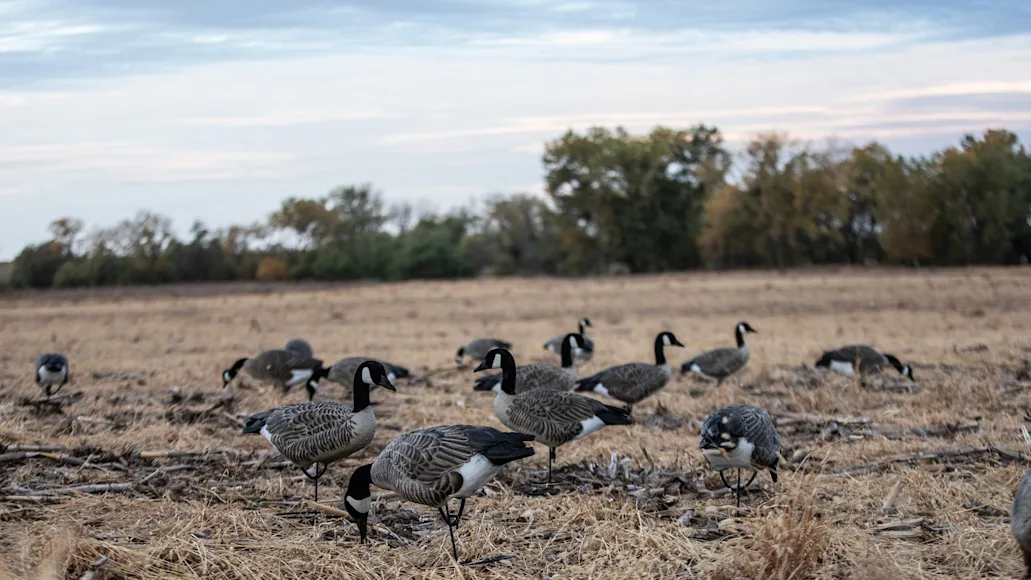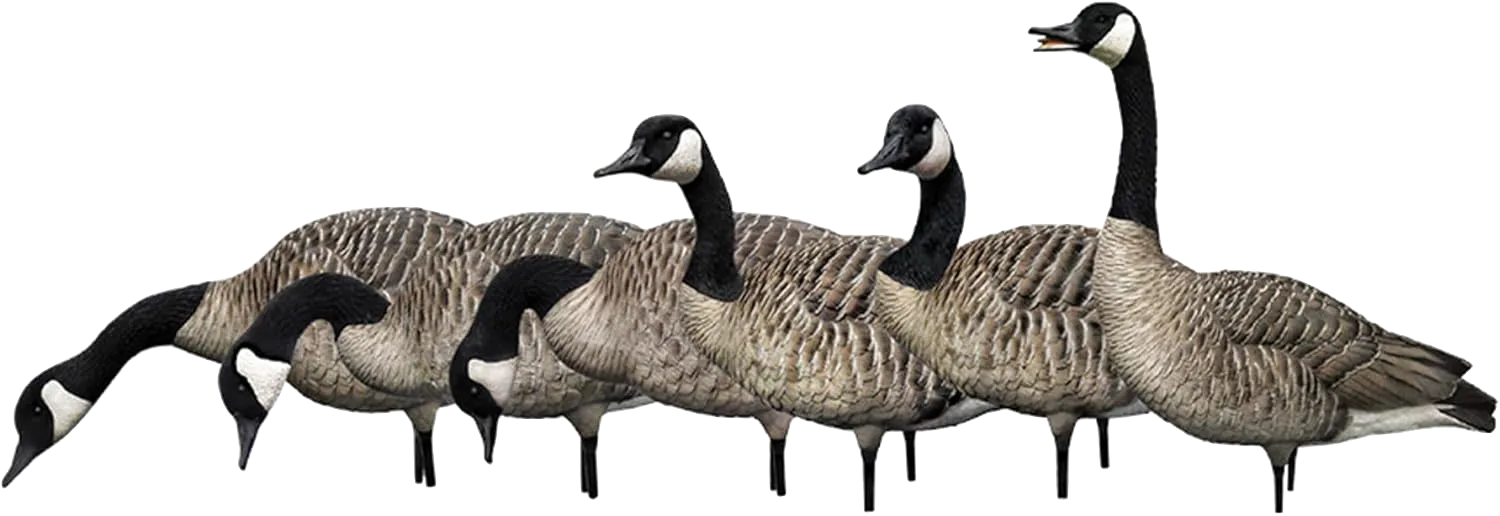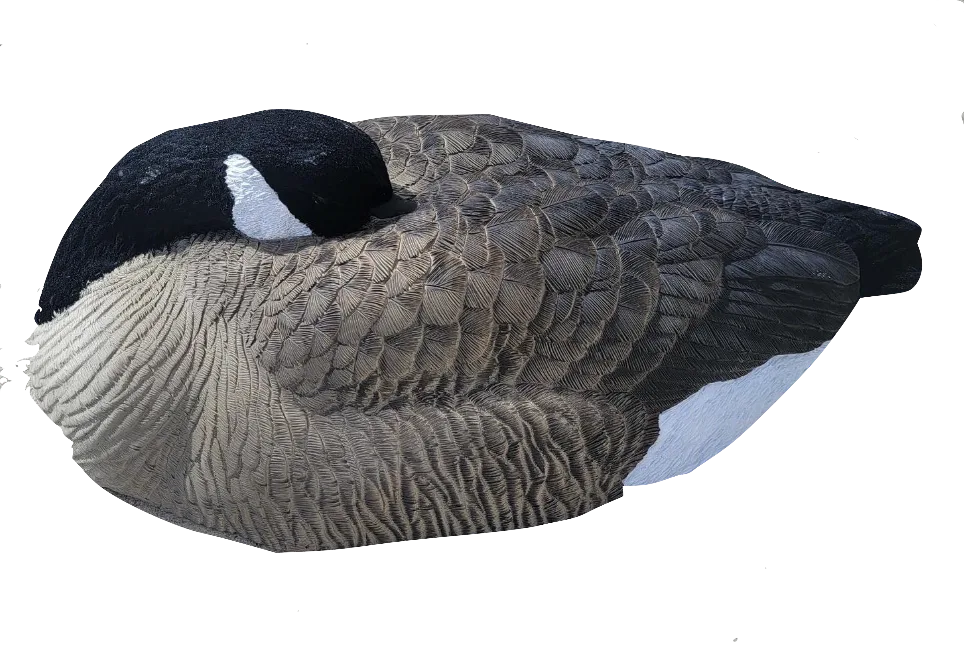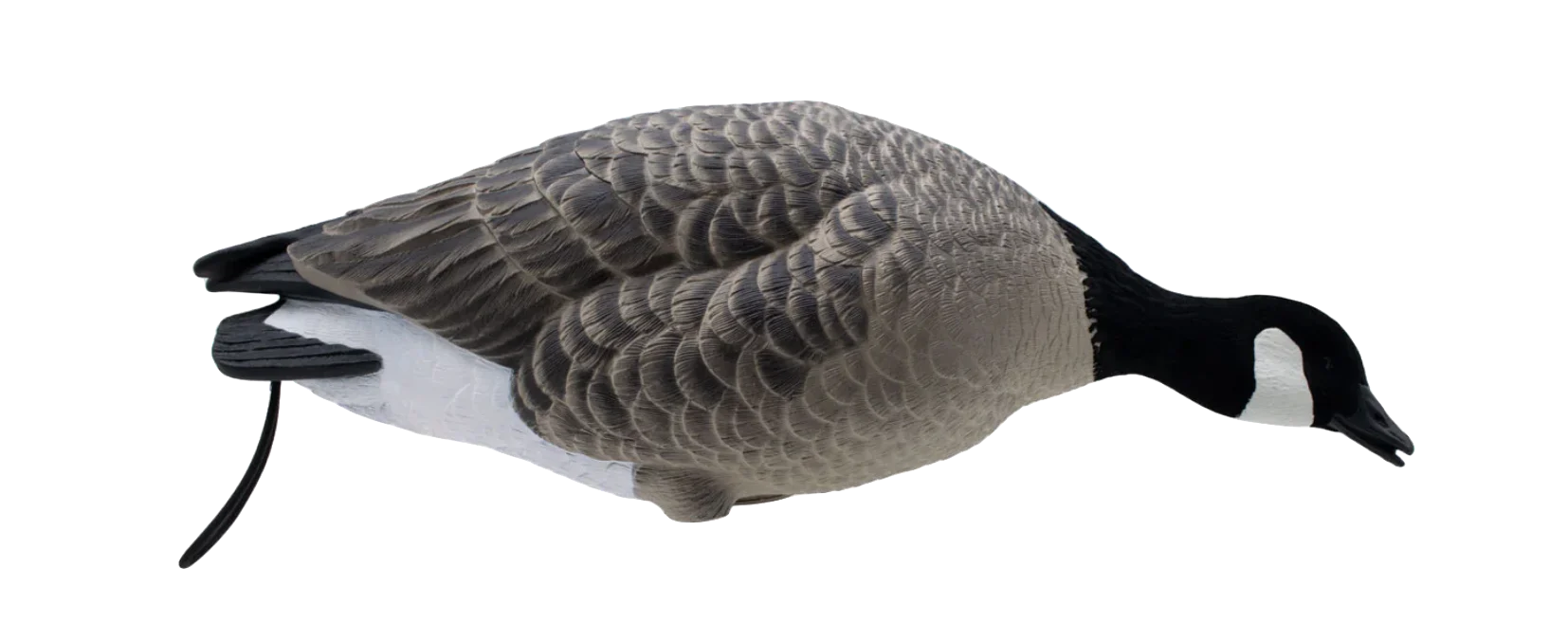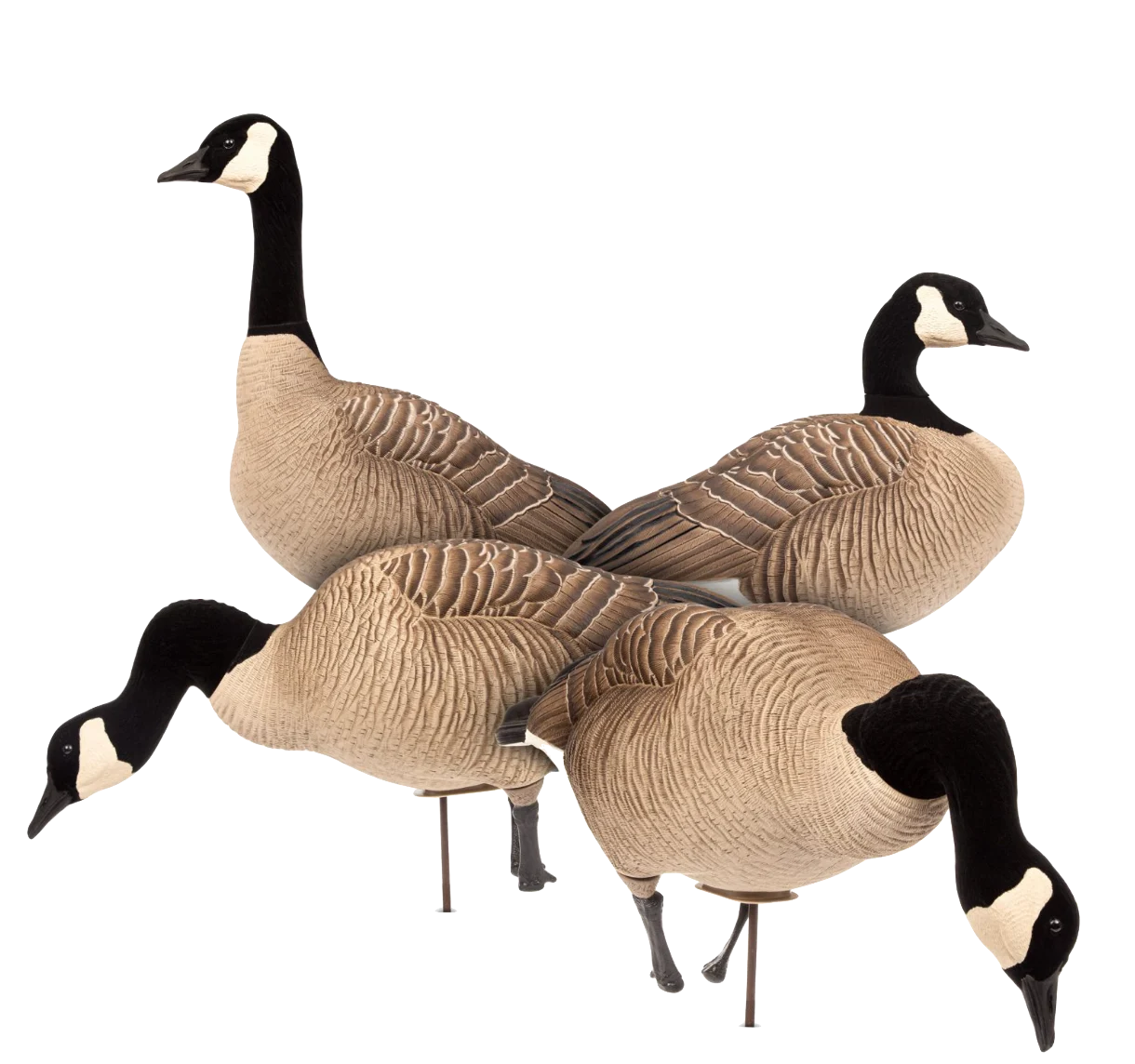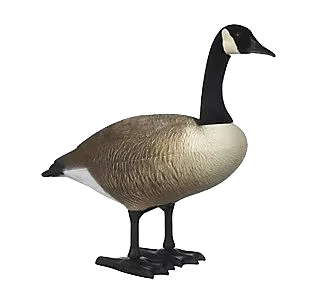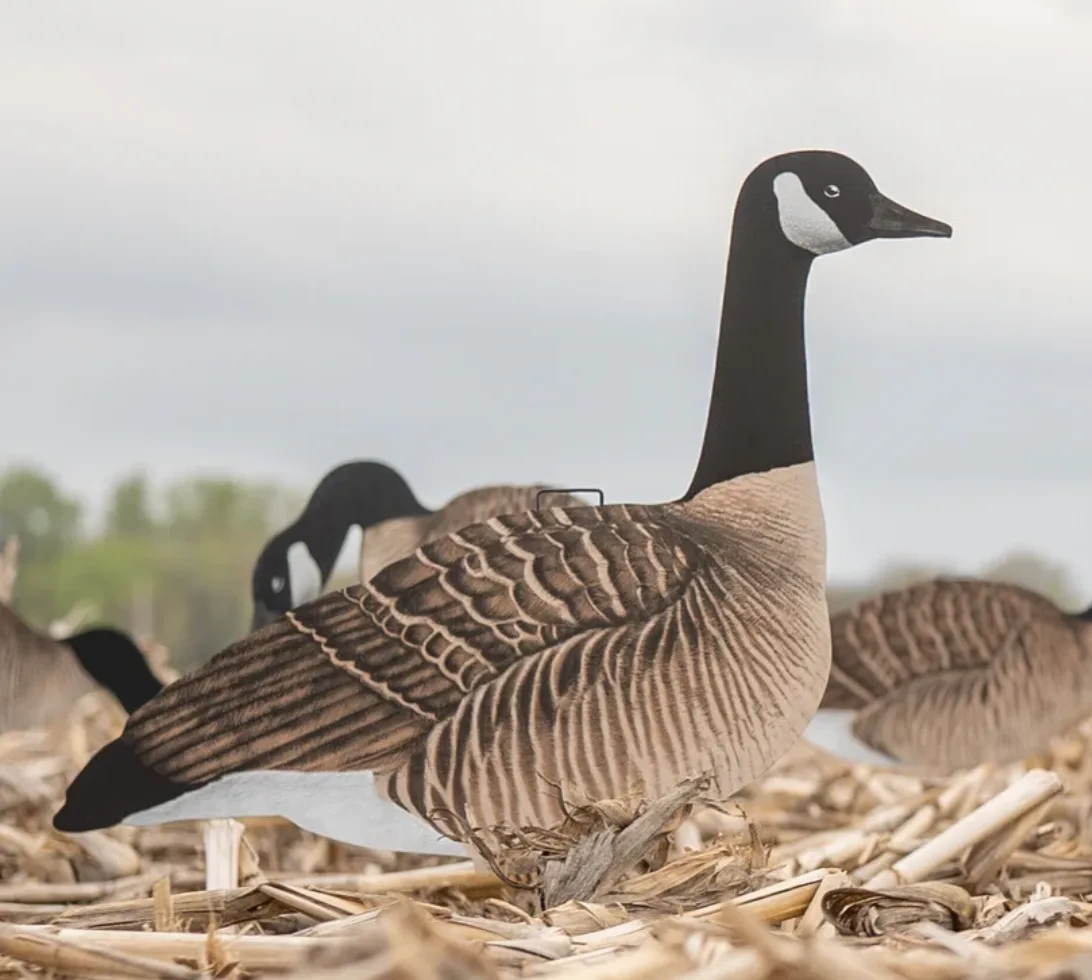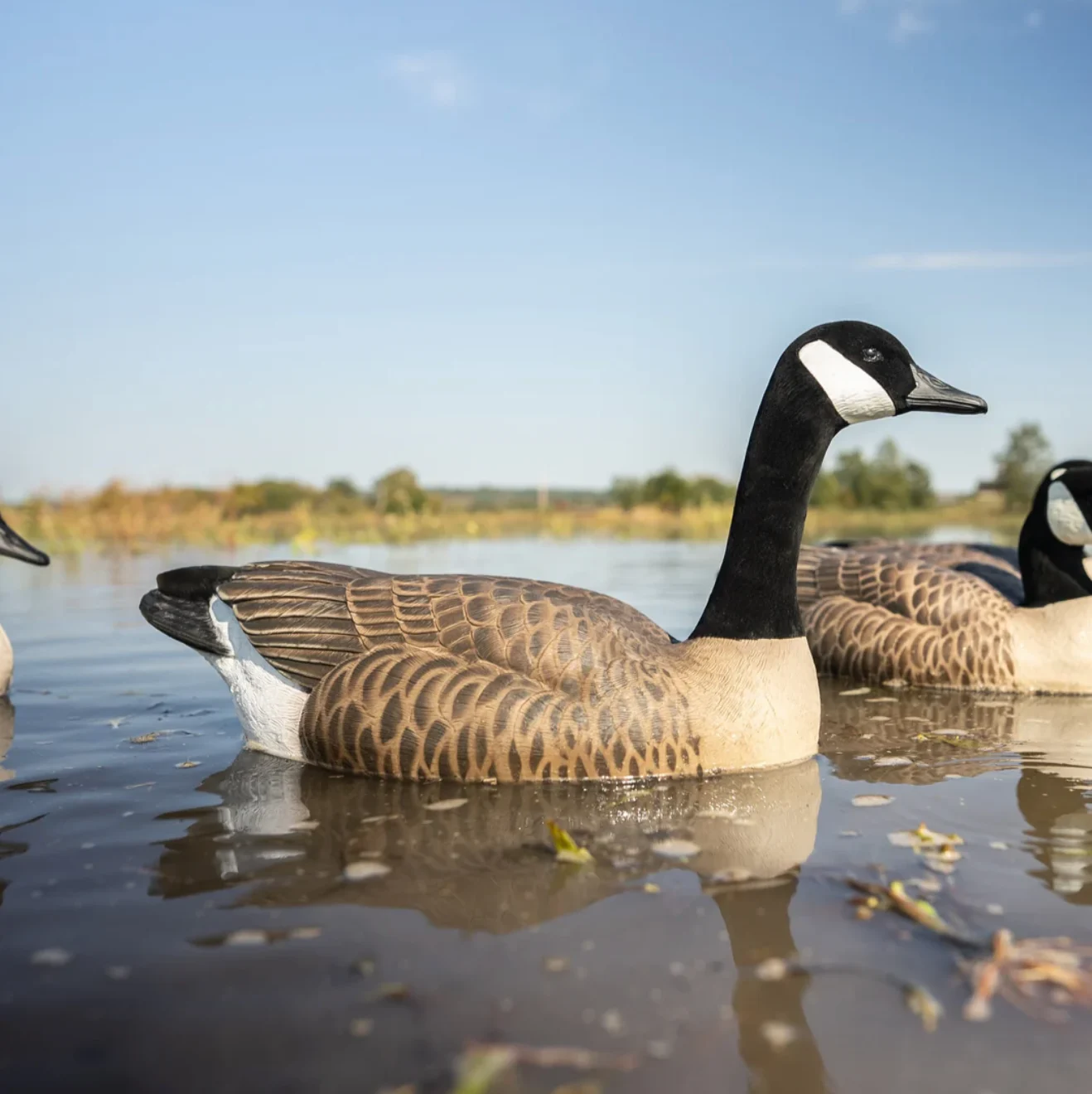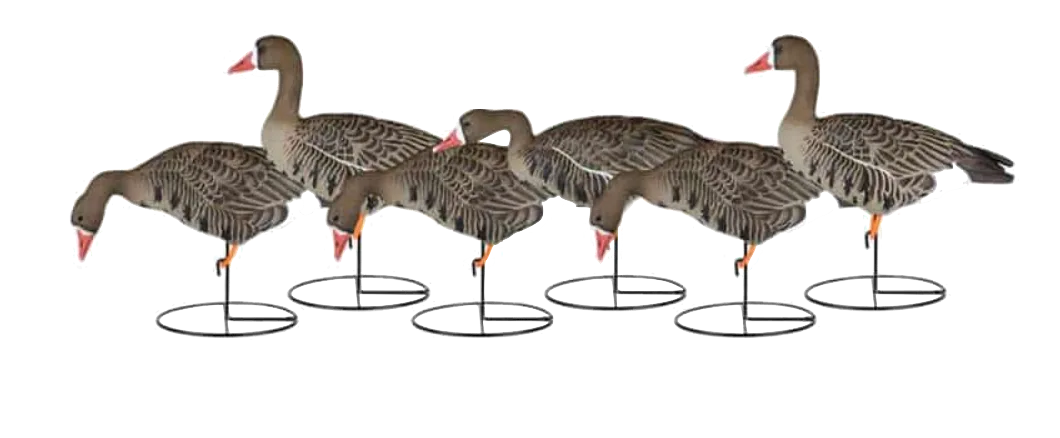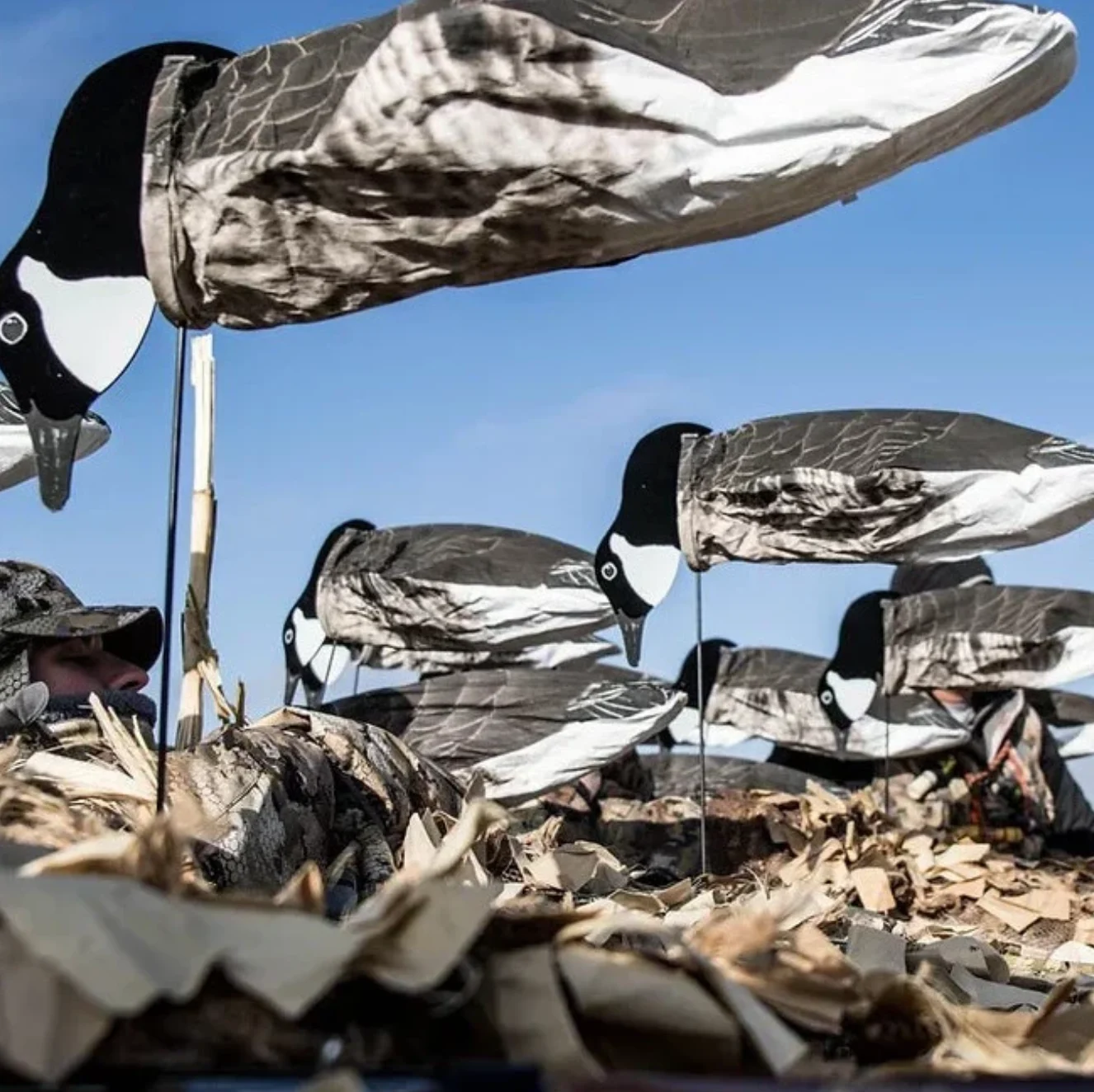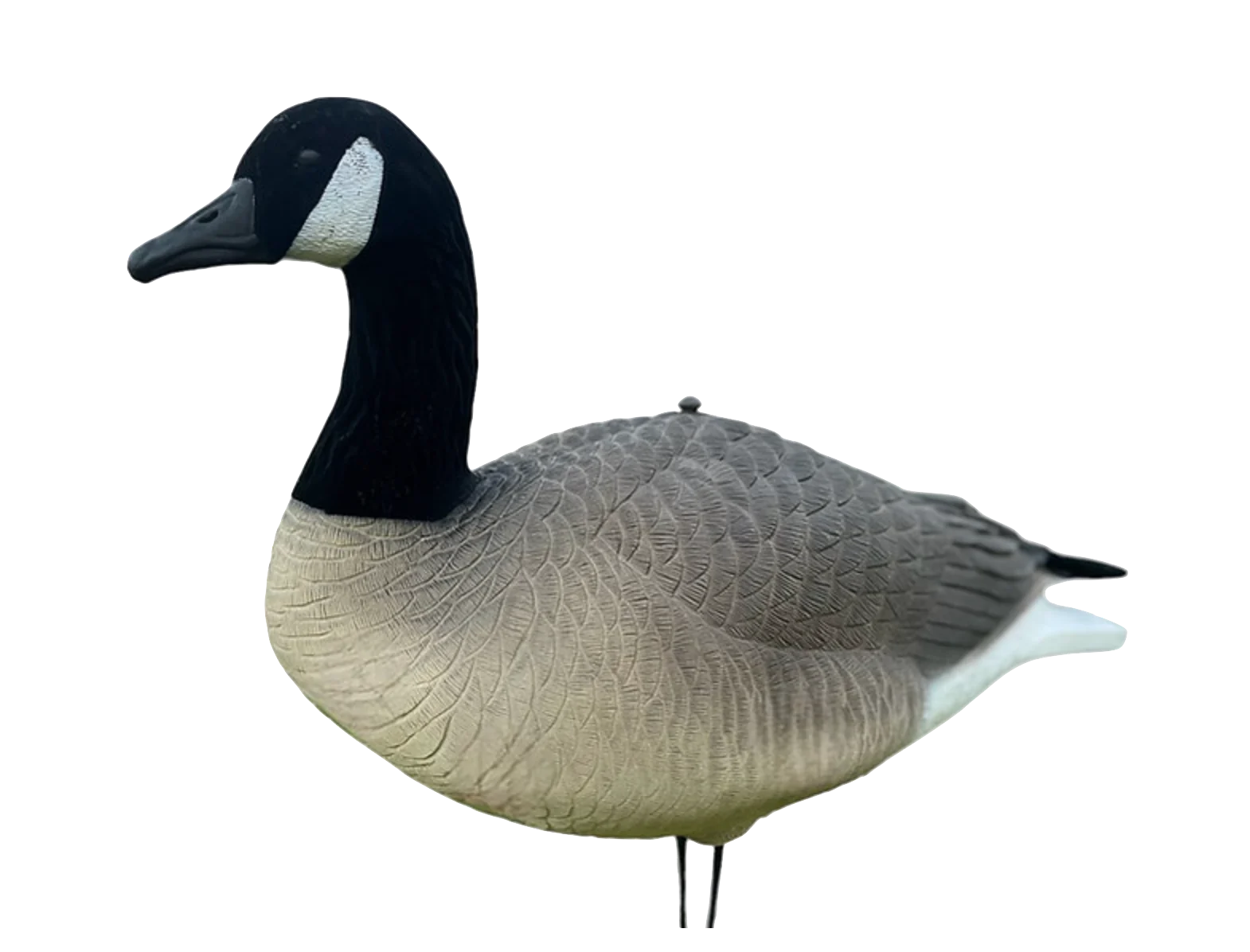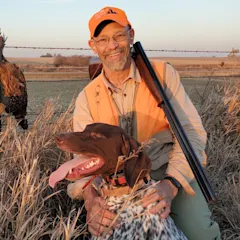We may earn revenue from the products available on this page and participate in affiliate programs. Learn more ›
It’s no secret that decoying geese is a thrill. Seeing geese close in on the spread and hearing them get louder as they come into range makes any waterfowler’s heart pound. But geese see a lot of decoys, and yours has to be set in the right place at the right time and look good, too. That matters, trust me.
Not every decoy type is best for every situation. Sometimes you need numbers and other times you need realism. Portability can be crucial if you need to transport gear into the field. And if everybody else is hunting on dry land, floater decoys on a loafing pond might be the answer. Think of your decoy collection like a tool kit. Not every tool is right for every job, and it can pay to have several options available.
Canada and specklebelly hunting usually require more realism and fewer decoys than snow goose hunting, which is a numbers game. Picking the right Canada goose decoys and the right specklebelly goose decoys means balancing realism and expense. Here’s a guide to the best goose decoys for both species.
Best Full Body Canada: Avian AXP Honker
Best Full Body Lesser Canada: FA Live Full Body Lesser Canada
Best Oversized Full Bodies: Dave Smith Decoys Maxima Honkers
Best Budget Full Bodies: Bigfoot B2
Best Lightweight Silhouettes: Divebomb V3
Best Shells: SX Sleeper Shells
Best Floaters: Dive Bomb F1 Canadas
Best Packable Floaters: Hardcore Rugged Series Lesser Canada
Best Full Body Whitefront: Dakota Decoy Fully Flocked X-Treme Specks
Best Field Socks: Dive Bomb Tall Socks
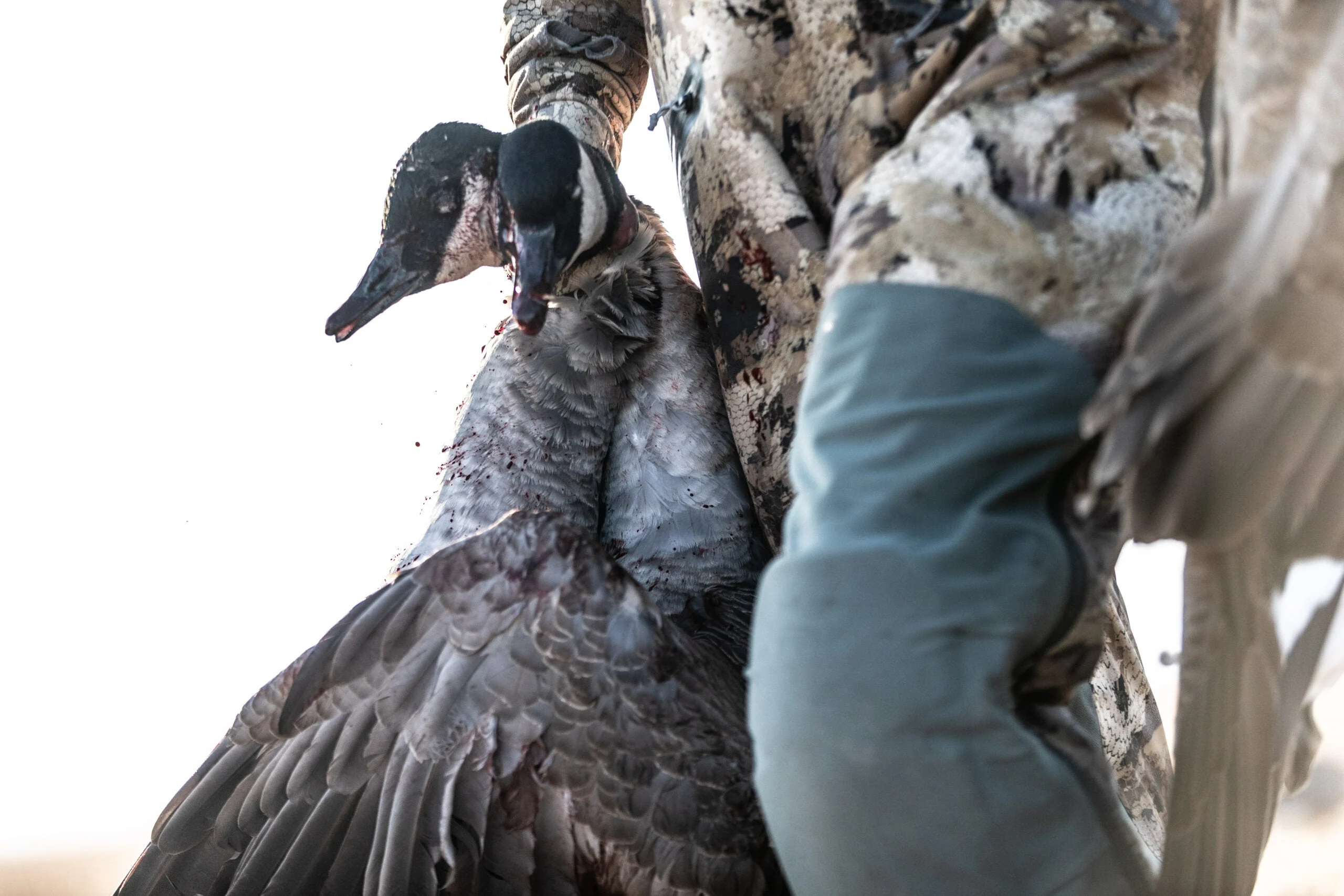
How We Picked the Best Goose Decoys
Goose decoys have to be able to take a beating and look good doing it. You can baby your decoys by storing them in individual bags to protect a flocked finish, but most people don’t want to do that. When I pick up a goose spread after sunset on a zero-degree day, I want to get out of the field and into someplace warm as fast as I can. If that means some decoys get knocked around, too bad.
Likewise, if I set a spread of floaters, they will be unbagged and Texas-rigged, which inevitably means they get tossed into pickup beds, banged into one another, and sometimes one or two get dragged behind the truck by accident (this especially doesn’t go well for two-piece decoys). I’ll stash decoys, too, so I don’t have to pack them in every time I hunt my local sandbars and ponds—exposing them to nasty weather all season long. So yes, I can be tough on decoys, just like most other serious waterfowlers.
At the same time, I’ve had plenty of geese look at my decoys and slide off to the side instead of coming in. Geese can be tough to fool, and lifelike decoys may not guarantee success, but they sure do help, and they help you stay confident in your setup, too. I have been beating up on goose decoys (and sometimes beating up on real geese) for quite a few seasons now. The decoys listed here will perform in the field. Here’s how I evaluated them:
Realism: Do they look like geese? Geese communicate through body language, so the decoys must be posed correctly to send the right message to birds overhead.
Durability: Will they hold up year after year? Decoys are expensive, and goose hunters often own lots. You want to be adding to your spread year after year, not replacing old decoys.
Weight and Size: Sometimes, bigger is better for greater visibility. Other times, you want a smaller decoy that’s easier to store, transport, and haul into the field in greater numbers.
Ergonomics: Do the decoy bases allow them to move? Do the bases or stakes make it easy to pick up your spread? Can you set these decoys in frozen ground? Do they have tail loops for easier pickup?
Price/Value: Are they worth your money? Will you have to replace them too soon? Are you getting the features you want?
Best Full Body Canada: Avian AXP Honker
Specs
Species: Canada geese
Decoy type: Full body
Decoys per box: 6
Finish: Flocked heads, painted bodies
Pros
Large, for good visibility
The attached collapsible base makes for easy setup and pick-up
Realistic poses
Cons
Slightly shiny (but geese don’t seem to mind)
Made of forgiving plastic, with tough paint and heads fixed to the bodies at the factory, Avian AXP honkers are both good-looking and tough. Their attached bases set them apart. Push down on the decoy’s back to retract the base, and step on its square frame to pop it up and deploy. It’s simple and lends itself perfectly to “throw and go” hunting, where you skip the slotted bags and toss decoys in a giant grain sack or right into a pickup bed. And, on cold days when real geese naturally hunker on the ground, you can set these with the bases retracted for a realistic presentation.
Best Full Body Lesser Canada: FA Live Full Body Lesser Canada
Specs
Species: Lesser Canada geese
Decoy type: Full body
Decoys per box: 6
Finish: Flocked heads, painted bodies, fully flocked also available
Pros
Convenient size
Motion system works in very light wind
Elastic tail loops for easy pickup
One-piece construction
Cons
Comes only with stakes, no ring base for frozen ground
Lesser Canada goose decoys, designed to mimic the smaller, short-necked species of Canada, also work on big geese. For those of us with limited space in our homes and vehicles, using lesser full bodies lets us store more decoys and bring more to the field. Big geese don’t mind the size difference at all. Of course, these work on real lessers, too.
The FA decoys are made of durable, flexible plastic. They are one piece, so you can’t break off a head. The carvings are realistic with great feather detail and they have elastic tail loops so you can carry several at once. The motion stake lets them move in a slight breeze. It is just a stake, though, so you may have to bring a drill or a punch to set these in frozen ground. Personally, rather than fight frozen ground, I’ll set decoys on cornstalks or just place them on the ground.
Best Oversized Full Bodies: Dave Smith Decoys Maxima Honkers
Specs
Species: Canada geese
Decoy Type: Full body
Geese Per Box: 4
Finish: Paint with flocked heads
Pros
Big for visibility
Lifelike pose and detail
Motion cone system
Cons
Two-piece construction
Square bases sold separately
The Maxima line offers hunters a lower-priced version of Dave Smith’s famous realism, but at nowhere near the $100-apiece cost of the A.C.E. top-of-the-line models. The Maximas are huge, for, well, maximum visibility, yet at under three pounds apiece, they are lightweight for their size. The full-body four-pack comes with two feeders, a rester, and a sentry. They are two-piece decoys, with separate, flocked heads. The level of feather detail is what you’d expect from a premium maker like DSD. The motion cone allows you to set the decoy to move about 20 degrees on one setting, and closer to 60 degrees for a lifelike back-and-forth feeding motion without spinning like a weather vane. Motion stakes are included with the decoys. Square-bottomed motion bases, beloved by those who hunt on frozen ground, are an extra with these, selling for $30 per four.
Best Budget Full Bodies: Bigfoot B2
Specs
Species: Canada geese
Decoy Type: Full body
Geese per box: 4
Finish: Paint
Pros
Durable
Easy setup
Inexpensive
Cons
Bulky
Introduced in 1984, Bigfoots were the last word in full body decoys for years. While other designs have passed them in terms of realism and motion, don’t dismiss these goofy-looking full bodies, especially if you’re on a budget. They are called Bigfoots for a reason: their base consists of a pair of comically giant goose feet, which you press into the base and leave attached. That design makes them easy to set up. They are the original throw-and-go decoy, as they are both bulky and tough enough that tossing them into the back of a trailer is the easiest way to go. You can pop the feet off and store them in conventional bags for off-season storage or between trips, but these decoys are best for those who leave them intact, which means you need a lot of space to transport them.
Best Lightweight Silhouettes: Divebomb V3
Specs
Species: Canada Goose/Honker
Style: Silhouette
Geese per box: 12
Finish: Printed with flocked head, fully flocked also available
Pros
Upgraded printing for feather-detail and 3-D appearance
Light and easy to pack
Affordable
Cons
Durability issues
Coroplast silhouette decoys are the rage for good reason. They are lightweight, weighing six pounds per dozen, easy to carry and store, and affordable. They set up quickly and pick up even faster. No, they won’t last forever, nor will you display one on your mantlepiece someday, but they get the job done in the field.
Dive Bomb, one of the leaders of the recent silhouette trend, offers its new, upgraded V3 to fill a niche and a price point ($99/dozen) between its basic V2 silos and the fully flocked version. Printed on an improved, no-glare surface, these look remarkably realistic, with a warmer, browner tone and great contrast on the feather detail. Shaded cheek patches that give a 3-D appearance, at least to the human eye. The spring-steel stakes are now textured to provide a better grip on the dirt, and they are also completely non-glare. Each box contains six feeders, two searchers, two resters, and two uprights.
Best Shells: SX Sleeper Shells
Specs
Species: Canada geese
Style: Shell
Geese per box: 6 or 12
Finish: Painted or flocked
Pros
Big
One-piece construction
Tail loops
Cons
Expensive
Shells have fallen out of favor among goose hunters who believe they need the realism and visibility of full bodies. In truth, shells work. They stack, and in some cases, they mimic real geese flopping on their bellies in cold weather. Sleeper shells have a place in any goose hunter’s decoy arsenal. They are perfect in snowy fields, on sandbars, and around holes in the ice. Whenever you use them, they add a suggestion that all is calm and well with the flock.
SX shells look great. They have flocked heads and tails, and if you want to go the extra mile in realism, you can get them fully flocked. They are also big, which helps them show up well amid the stubble and totally pop against snow or sand. They have tail loops for easy pickup, and, being one-piece, they are easy to stack. The fully-flocked decoys require extra care, though, and flock SX sleepers come with individual bags so their fake feathers remain unruffled.
Best Floaters: Dive Bomb F1 Canadas
Specs
Species: Canada geese
Decoy type: Floater
Decoys per box: 6 or 24
Finish: Flocked heads, painted bodies
Pros
One-piece design
Flocked heads
Tough paint
Cons
Often sold out
Having assembled a Canada floater spread consisting of a little bit of this and a little bit of that, I’ve tried a lot of different floaters. And they all fool geese, but I wish all of mine were Dive Bomb F1 floaters. The F1s are big, but not so big as to be ungainly, as some of my other floaters are. They are one-piece, and made of soft, rugged plastic, so it takes some doing to break off a head or otherwise damage these things.
The poses are lifelike, and the feather detail is great. I used them on several hunts last year
and liked everything about them. The only problem is Dive Bomb only sells directly, and I am not the only person who knows how good these floaters are. They are often sold out.
Best Packable Floaters: Hardcore Rugged Series Lesser Canada
Specs
Species: Lesser Canada geese
Decoy type: Floaters
Decoys per box: 6
Finish: Paint, flocked heads
Pros
One-piece
Flocked head
Good feather detail
Cons
Small
The small size of Hardcore’s Rugged Series Lesser Canada floaters is both a glitch and a feature. Yes, they are small, and won’t show up as well as a bigger decoy might. But that small size, not much bigger than a standard mallard, means you can pack a dozen of those on your back or fill your boat with ease.
I use these decoys on moving water, and they make a wake and stand out just fine despite their small size. Those white butts and cheek patches show up, too. While small, they deliver big performance in terms of look and durability. The paint is tough, the flocking looks good, and they are one piece, so there are no lost heads. I have been using an early production version of these for years. The new ones have even better paint.
Best Full Body Whitefront: Dakota Decoy Fully Flocked X-Treme Specks
Specs
Species: White-fronted geese
Decoy Type: Full body
Decoys per box: 6
Finish: Fully flocked (painted also available)
Pros
Lifelike
Large size
Motion stake stays attached with bungee
Cons
Expensive
There are two ways to hunt whitefronts: with a bunch of socks and silhouettes, or a smaller spread of very lifelike decoys. Some hunters use as few as six or eight very realistic speck decoys. Dakota’s X-Treme Speck full bodies present the ultimate in realism if you choose the minimalist route, especially if you do with the fully flocked variant of this good-looking decoy. Speck hunting sometimes takes place in sheetwater or soggy fields, and flocking looks even more realistic when it gets wet.
The X-Treme specks are fully flocked, and each box of six presents three different poses. All of them come with Dakota’s Wind Walker motion base, which allows the decoys to swing back and forth in the wind and also attaches the decoy to the base by means of a bungee that makes it into a single unit so it’s easy to rearrange the spread and to pick up. These decoys are tough as they are good-looking. They are one-piece and made of Dakota’s MEVA soft plastic to survive the inevitable bumps of field use.
Best Field Socks: Dive Bomb Tall Socks
Specs
Species: Canada, speck, snow
Decoy Type: Windsock
Decoys per box: 12
Pros
Flocked heads and realistic color
36-inch stakes
Tough material
Cons
Heavier than some competitor socks
These tall socks, with extra-long, 36-inch stakes, can go anywhere. They allow you to set up in tall stubble or sheetwater, where decoys on shorter stakes might beat themselves to pieces or get waterlogged. Tall socks also enable you to hide in the spread underneath the windsocks, putting you right in the middle of the decoying action. While most Canada hunters use socks out west in big spreads for lessers, they can add motion to a honker spread, too.
Dive Bombs feature flocked heads and good color schemes on their tough Tyvek bodies. The backbones keep the decoys from sagging on no-wind days and snap down easily for storage. Likewise, the sock mouth has zero-memory springs for long-term durability. These socks come fully assembled with no small parts to lose. They are available as specks, Canadas, and snows.
GHG Pro-Flex Fullbody Honker Harvester Pack
Specs
Species: Canada
Decoy Type: Full body
Decoys per box: 12
Pros
Lightweight
Tough material
Cons
Small
Banded’s GHG Pro-Flex decoys follow the current trend of smaller, cheaper, lighter decoys. They are really small, about the size of GHG’s lesser decoys. The small size means these are lightweight, though. Decoy plus a stake weighs a pound, so you can fit a lot of them into a small vehicle, and I don’t like to think about how many you could put in a big trailer. They are soft EVA, so they flex and, I’ve found, don’t need to be popped back into shape much. They have flocked heads and tails, plus tail loops. They make use of the Motion Cone system, and the stakes are common to all GHG decoys. You can set the decoy to lock in place or to move through a wide range of motion without doing unrealistic 360-degree spins. I like the motion cone system because often, in cold weather, I’ll skip stakes and set decoy cones onto cornstalks.
The Harvester pack comes with three walkers, resters, and left and right feeders for $269. These are lifelike, and while they are the size of lesser Canadas, they have big-goose proportions, meaning their necks are the right length. Did I mention these are small? They are, but it’s a feature, not a glitch. Big decoys show up, but I believe it’s the high-contrast heads, necks, and tails that really make the difference. The more of those you have on the ground, the more visible your spread.
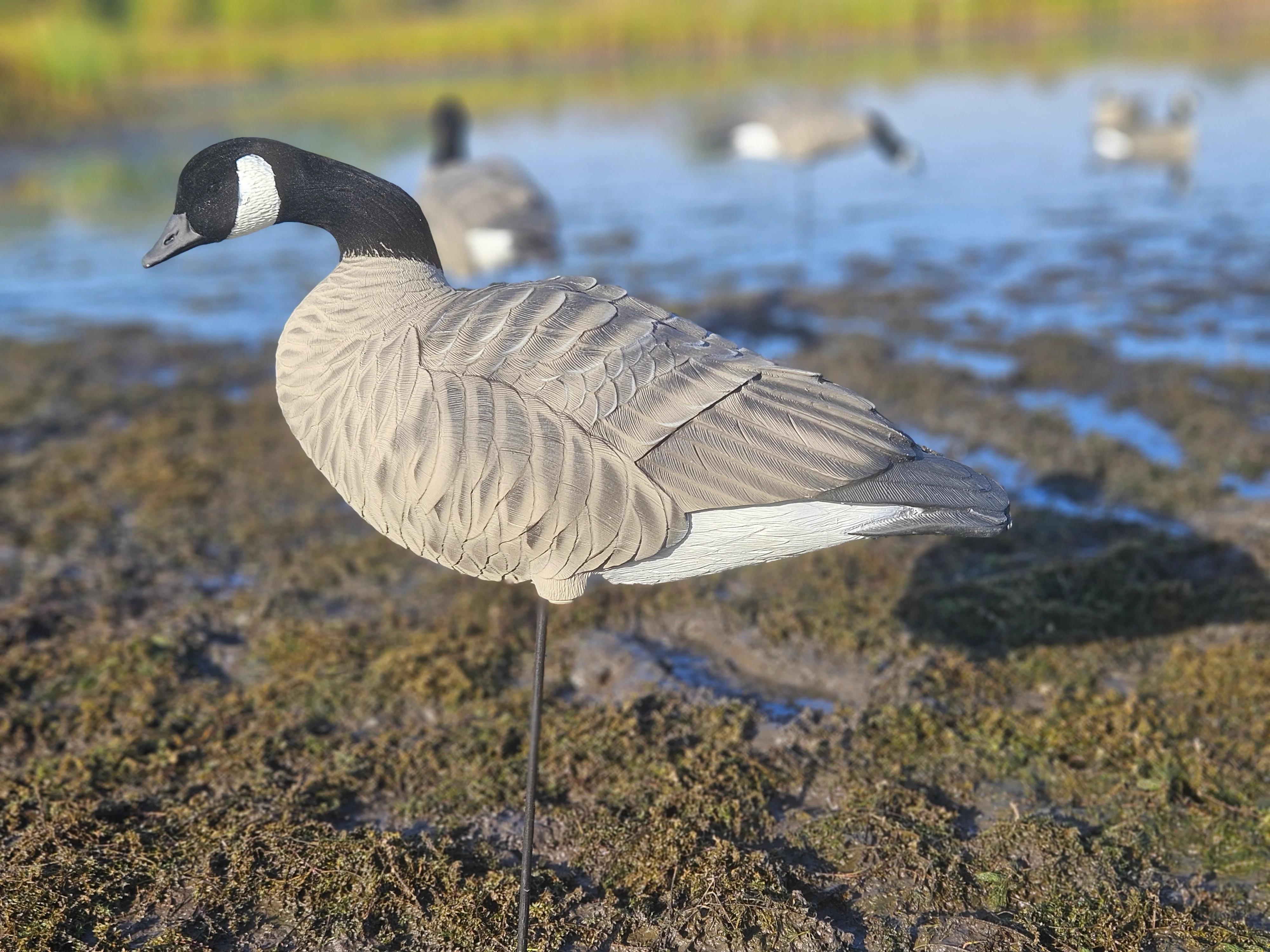
Gym Shoe Canadas
Specs
Species: Canadas (tested), snows, specks
Decoy Type: Full body
Decoys per box: 12
Pros
Stakes attached
Large size
Flocked heads and tails
Cons
Assembly required
Big bag
Gym Shoe decoys are the ultimate in Throw-and-Go convenience. Smaller than standard full-bodies, they are still good-sized, measuring 23 to 26 inches long and 28 inches around. They’re made of soft EVA that lets them give instead of scuff. The stakes pop in, and once secured with the bungee that also serves as a motion limiter, they form a one-piece decoy/stake unit. Fully assembled, they weigh 20 ounces apiece. That makes these perfect for walk-in hunters, who can carry two or three dozen, or more if you’re motivated. You get nine feeders and three uprights, all for $229, so it’s relatively affordable to build a spread. Flocked heads and tails help them look good, too.
These decoys do have some downsides. You have to soften each decoy with a hairdryer out of the box and attach the hook for the bungee cord with a wingnut that you should probably Loctite into place. They do not come with tail loops but have a tail loop loop so you can make your own. You do occasionally have to pop out a dent in the side, but these decoys are made for abuse. The bag, sold separately, is like a smaller version of the seed bags Throw-and-Go hunters prefer, but on the first tote in with mine, stakes poked through the sides. I’d find a bag that matched these decoys for toughness.
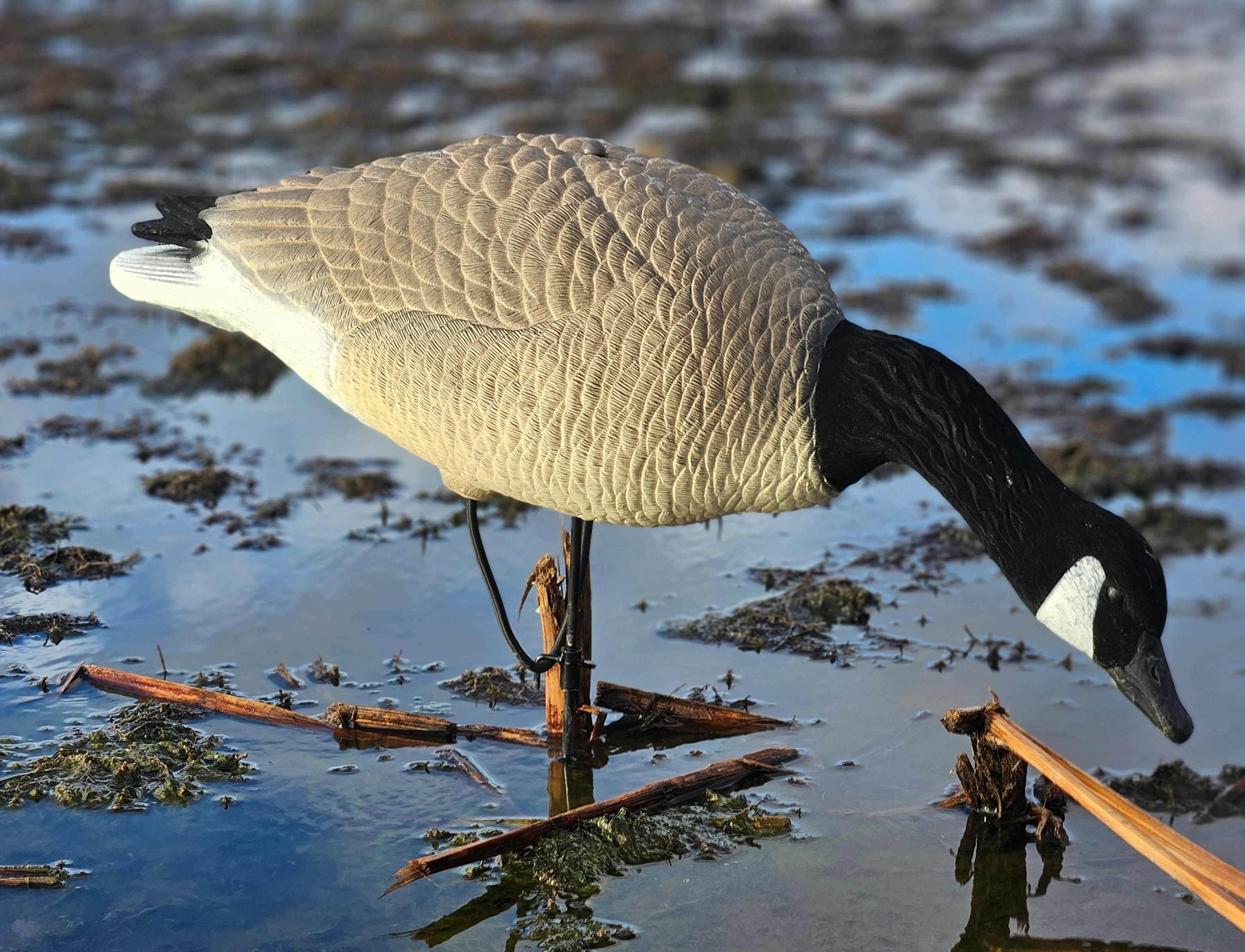
Things to Consider Before Buying the Best Goose Decoys
Buying goose decoys begins with species choice. While geese decoy best to their own kind, they will also often decoy to other species. Specks will often come to a Canada spread, or to a snow goose spread, so you may not have to buy more than one species of decoy.
As for type, serious Canada goose (honker) hunters believe that realism kills and usually prefer full bodies or silhouettes, and dismiss socks as best for lesser Canada geese. While there is some truth to that, don’t be afraid to experiment with socks to add motion to your spread. Some hunters believe that giving geese something different to look at matters, so having a variety of decoy types lets you change up your look.
How much space do you have to store and transport decoys? I am here to tell you that if you live in a small house and drive a small vehicle, you can still shoot geese, but you may rely on a few lesser decoys or a lot of silhouettes to do it. Lessers take up much less space than honker decoys, and a bag of five dozen silhouettes takes up less space than one bag of full-body lessers.
How big a spread do you need? Most of my hunting experience is with big Canadas, and I’ve had great hunts with 30 decoys or less. One reason is that I often hunt alone, and I only have to hide one person. That makes a difference, as one function of a decoy spread is to distract the geese from your presence. If you hunt in a big group for specks or Canadas or hunt lessers out west, you may want many dozens of decoys.
FAQs
Q: How many decoys should I buy?
Buy a few good decoys this year and a few more next year. Have your hunting buddies do the same, and soon, you will be awash in decoys. Make it a point to buy decoys at the end of every season, when they’re on sale. Watch for used decoys at yard sales and on social media.
Q: Can you hunt ducks with goose decoys?
Ducks love goose decoys, and in many places, the best duck spread is a goose spread. Ducks know geese like to eat the same things they do. And, goose decoys show up from a long way away. In a dry field, you can set out nothing but goose decoys and a spinning wing duck decoy and be very successful. Be sure that the decoy is on a remote so you can shut it off when geese arrive, as they dislike spinners.
Over water, you don’t need the spinner, just some goose floaters. While you will see real ducks mixed in with geese, I would set mostly geese and a few ducks off to the side. Geese don’t like to fly over ducks, so put them on the downwind side and the ducks upwind.
Q: Can you mix decoy types?
Absolutely. My first spread consisted of a dozen full-body lessers and three dozen shells, and they got me started shooting birds. You can mix silhouettes in, and even windsocks if you want motion. Shells and sleeper shells are very effective, especially in snow, both because they look like real geese on their bellies and because they increase the size of your decoy spread. A good rule of thumb is to set your most realistic decoys around the landing hole, so they are the decoys the geese are looking at on their final approach.
Why Trust Us
For more than 125 years, Field & Stream has been providing readers with honest and authentic coverage of outdoor gear. Our writers and editors eat, sleep, and breathe the outdoors, and that passion comes through in our product reviews. You can count on F&S to keep you up to date on the best new gear. And when we write about a product—whether it’s a bass lure or a backpack—we cover the good and the bad, so you know exactly what to expect before you decide to make a purchase.

